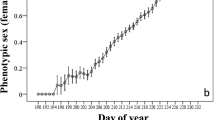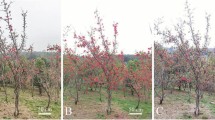Abstract.
The duration of pollen exposure and female receptivity in the winter flowering Helleborus bocconei Ten. and Helleborus foetidus L. were determined in the field. Experimental treatments were performed “in vitro” on cultivated flowers in order to investigate the abiotic factors regulating the patterns of pollen presentation and stigma receptivity. Correlation analysis with meteorological data in the field and the experimental results demonstrated temperature to be the main factor affecting the duration of anthesis and the number of anthers opening each day, whereas the duration of female receptivity mainly depends on whether or not pollination had occurred. This features may be an adaptation that allows biotic pollination under harsh environmental conditions.
Similar content being viewed by others
Author information
Authors and Affiliations
Additional information
The authors thank A. Dafni, D. Prado and J. Porter for helpful comments on an early version of the manuscript. Research conducted under FOMEC Grant to J.L.V., Ricerca d’Ateneo (Siena) and MURST (Rome).
Rights and permissions
About this article
Cite this article
Vesprini, J., Pacini, E. Temperature-dependent floral longevity in two Helleborus species. Plant Syst. Evol. 252, 63–70 (2005). https://doi.org/10.1007/s00606-004-0261-9
Received:
Accepted:
Published:
Issue Date:
DOI: https://doi.org/10.1007/s00606-004-0261-9




